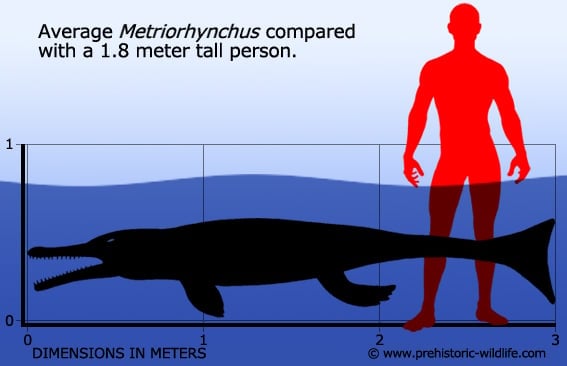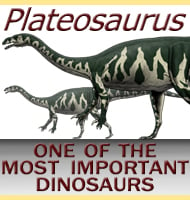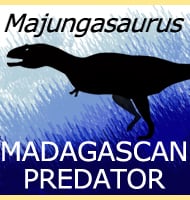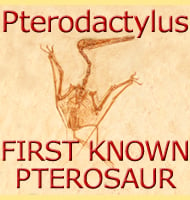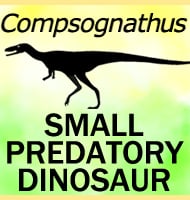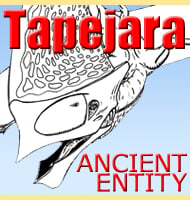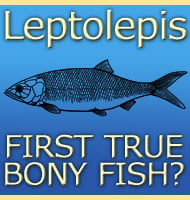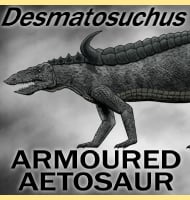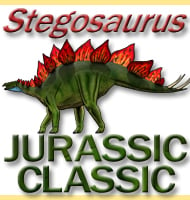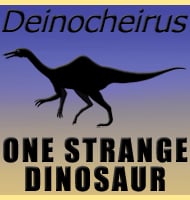In Depth
Metriorhynchus is one of the better known marine crocodiles with features that show it was more at home in the water than on the land. The legs have evolved to become more like flippers, and the tail sports evidence of a tail fluke. It is likely that the tail provided primary locomotion in the water with the legs being used for maneouvering.
One strong piece of evidence to suggest that Metriorhynchus spent most of its life in the water is the presence of salt glands. These salt glands are found in many marine animals and work by extracting excess salts from the blood so that they can be excreted externally in a concentrated form. By having an active gland constantly removing salt from the blood, marine creatures, including Metriorhynchus would have been able to drink seawater as well as eat other marine animals that would have had a higher salt content than land animals.
It is not known for certain if Metriorhynchus spent all of its time in the water or if it returned to the land. On land Metriorhynchus would have certainly been more cumbersome, as evidenced by its marine specialisations, but it may have had too for special tasks such as laying eggs, just like turtles have too. While other marine reptiles like icthyosaurs almost certainly gave birth to live young, it needs to be remembered that these evolved from different lines, and that Metriorhynchus had more immediate terrestrial ancestors, meaning that it may not have had enough evolutionary time to develop live birth at sea.
Although an active predator in its own right, there is also evidence for Metriorhynchus scavenging on animals like plesiosaurs, indicating an opportunistic lifestyle. In turn, Metriorhynchus may have been preyed upon by larger predators such as the short necked pliosaurs such as Pliosaurus and Liopleurodon. that swam the oceans at the same time. Other well known Mesozoic marine crocodiles include Geosaurus , Torvoneustes, Plesiosuchus and Dakosaurus.
Further Reading
– Achte Versammlung der Naturforscher und Aerzte zu Heidelberg im September 1829. – Isis von Oken, 1830: 517-519. – H. von Meyer – 1830. – M�moire sur les dinosauriens et les crocodiliens des terrains jurassiques de Boulogne-sur-Mer [Memoir on the dinosaurs and crocodilians of the Jurassic deposits of Boulogne-sur-mer]. – M�moires de la Soci�t� G�ologique de France, s�rie 2 10(2):1-57. – H. -E. Sauvage – 1874. – On a crocodilian jaw from the Oxford Clay of Peterborough. – Quarterly Journal of the Geological Society of London 46:284-288. – R. Lydekker – 1890. – The Mesozoic reptiles of Dorset. Part one. – Proceedings of the Dorset Natural History and Archaeological Society 79:47-72. – J. B. Delair – 1958. – Un nuevo cocodrilo marino (Crocodylia, Metriorhynchidae) del Caloviano del norte de Chile. [A new marine crocodile (Crocodylia, Metriorhynchidae) of Callovian of northern Chile.]. – Ameghiniana 17(2):97-10. – Z. B. Gasparini – 1980. – Radiation �volutive, pal�o�cologie et biog�ographie des Crocodiliens m�sosuchienes. [Adaptive radiation, paleoecology and biogeography of crocodiles m�sosuchienes] – M�moires Societ� Geologique de France 142: 1–88. – E. Buffetaut – 1982. – The Callovian (Middle Jurassic) marine crocodile Metriorhynchus from Central England. – Palaeontology 30 (1): 179-194. – S. M. Adams-Tresman – 1987. – Swimming capabilities of Mesozoic marine reptiles; implications for method of predation. – Paleobiology 14 (2):187-205. – J. A. Massare – 1988. – Evidence for scavenging by the marine crocodile Metriorhynchus on the carcass of a plesiosaur. – Proceedings of the Geologists’ Association 114: 363-366. – R. Forrest – 2003. – Salt glands in the fossil crocodile Metriorhynchus. – Journal of Vertebrate Paleontology 26 (4): 1009-1010. – R. Gandola, E. Buffetaut, N. Monaghan, G. Dyke – 2006. – Salt glands in the Jurassic metriorhynchid Geosaurus: implications for the evolution of osmoregulation in Mesozoic crocodyliforms. – Naturwissenschaften 95: 79-84. – 2008. – Un nuevo esp�cimen de cocodrilo marino del Jur�sico Medio del norte de Chile: revalidaci�n de Metriorhynchus westermanni (Crocodyliformes: Metriorhynchidae). [A new specimen of marine crocodile from the Middle Jurassic of northern Chile: revalidation Metriorhynchus westermanni (Crocodyliformes: Metriorhynchidae).] – Revista Geologica de Chile 35(2):335-346. – Z. Gasparini, A. Paulina-Carabajal & G. Chong – 2008. – The evolution of Metriorhynchoidea (Mesoeucrocodylia, Thalattosuchia): an integrated approach using geometrics morphometrics, analysis of disparity and biomechanics. – Zoological Journal of the Linnean Society 158: 801-859. – Mark T. Young, Stephen L. Brusatte, M. Ruta & Marco B. Andrade – 2009. – The evolution of Metriorhynchoidea (Mesoeucrocodylia, Thalattosuchia): an integrated approach using geometric morphometrics, analysis of disparity, and biomechanics. – Zoological Journal of the Linnean Society 158(4):801-859. – M. T. Young, S. L. Brusatte, M. Ruta & M. B. Andrade – 2010. – A new metriorhynchid crocodylomorph from the Lower Kimmeridge Clay Formation (Late Jurassic of England), with implications for the evolution of dermatocranium ornamentation in Geosaurini. – Zoological Journal of the Linnean Society 169:820-848. – M. T. Young, M. B. de Andrade, S. Etches & B. L. Beatty – 2013. – Filling the Corallian gap: New information on Late Jurassic marine reptile faunas from England. – Acta Palaeontologica Polonica 63 (2): 287–313. – D. Foffa, M. T. Young & S. L. Brusatte – 2018. – Cutting the Gordian knot: a historical and taxonomic revision of the Jurassic crocodylomorph Metriorhynchus. – Zoological Journal of the Linnean Society, zlaa092. – Mark T. Young, Arnaud Brignon, Sven Sachs, Jahn J. Hornung, Davide Foffa, James J. N. Kitson, Michela M. Johnson & Lorna Steel – 2020.
